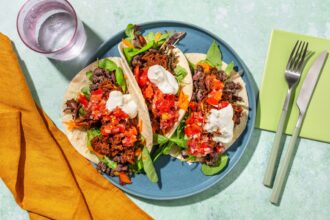How to cook pasta
June 6, 2024Pasta is a pantry essential for households worldwide – and for good reason. When it comes to pasta recipes and sauces, the possibilities are endless. Read on for some easy tips on cooking different pasta varieties, and try the most popular HelloFresh pasta recipes at home, like this creamy truffle & bacon fettuccine recipe.
What is pasta made from?
Pasta is typically made from an unleavened dough of wheat flour, meaning it’s made without yeast and mixed with water or eggs. The mixture is formed into sheets and then cut in order to create strips or other pasta shapes.
Varieties of pasta
Pasta is available in a wide array of shapes and sizes, offering both fresh and dried varieties.
Main types of pasta
Here are some recipes of the pasta variations you can expect to find in New Zealand:
- Macaroni – the small, tube-shaped noodles found in this mac & greens recipe.
- Fettuccine – long, narrow ribbon-shaped noodles featured in this mushroom & leek fettuccine recipe.
- Fusilli – thick, spiral-shaped pasta, like those used in this pesto ragu fusilli recipe.
- Penne – tube-shaped, cut diagonally at both ends, just like in this creamy chicken penne recipe.
- Risoni – small, rice-like shape noodles featured in this pesto risoni recipe.
- Spaghetti – long, thin ribbon-shaped noodles used in our easy spaghetti recipes.
- Linguine – long, flat ribbons, slightly thicker than spaghetti, but just as delicious in this rosemary linguine recipe.
- Rigatoni – short, wide tube-shaped pasta with ridges.
- Ravioli – square or round pillow-shaped with fillings, which feature in this pumpkin ravioli recipe.
- Lasagne – long, wide, flat and sheet-like noodles, layered in this veggie lasagna recipe.
Difference between dried and fresh pasta
You can find dried or fresh versions of most pasta varieties. Most pasta that is left to dry is made with a different kind of dough and without eggs, which, along with flour, are the primary ingredients in fresh pasta. Fresh pasta has a significantly shorter cooking time and shelf life than dried pasta.
How to cook pasta
The most common way to cook pasta is by boiling it in water. The cooking times for pasta may vary based on the type of pasta and your desired texture.
How to boil pasta
- Bring water to the boil on the stove, adding a pinch or two of salt.
- Once boiling, add your pasta to the water. While it might be tempting to add pasta to the pot before the water reaches a boil, waiting ensures the pasta will keep its texture, preventing it from becoming mushy.
- Boil the pasta for approximately 7-10 minutes, adjusting the cooking time based on its density. Cook fresh pasta for a shorter time of around 4-5 minutes. If you prefer pasta al dente, reduce the cooking time by around 1½ minutes.
All cooking appliances vary. These are guidelines only. Ensure the food is piping hot before serving. Do not reheat.
What is al dente pasta?
Translated from Italian, al dente literally means “to the tooth”. Pasta is considered to be al dente when it is still firm to bite rather than being overcooked and overly soft. Al dente pasta will have a slight resistance when bitten into, unlike pasta that is fully cooked. It is suggested that there is evidence to show that al dente pasta may help you feel fuller for longer, as it has a low-to-medium glycemic index (gi) value, which means the body digests it slower than some other carbohydrate-rich foods.
Pasta recipes
With its versatility and convenience, pasta offers an array of mouthwatering possibilities, sure to delight your friends, family, and guests. Explore some of the most popular pasta recipes from HelloFresh:
- Easy Linguine Carbonara Recipe
- Nan’s Creamy Chicken Penne Recipe
- Italian Lamb Ragu & Spaghetti Recipe
All food products vary. The instructions printed on the food packaging always supersedes those printed in this article and must always be followed.









